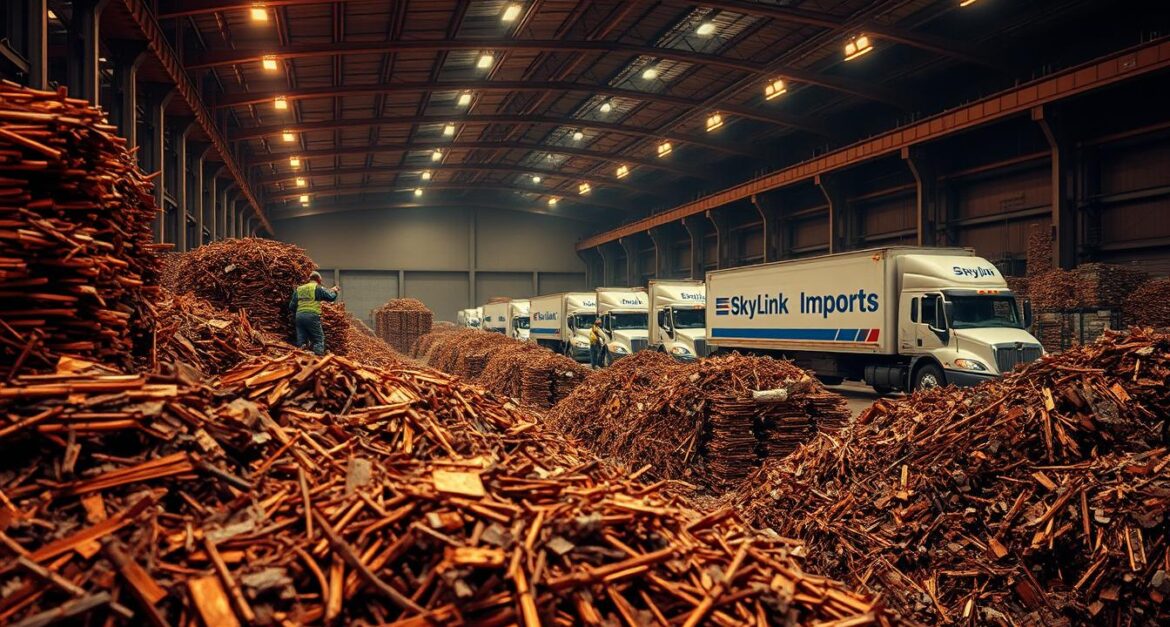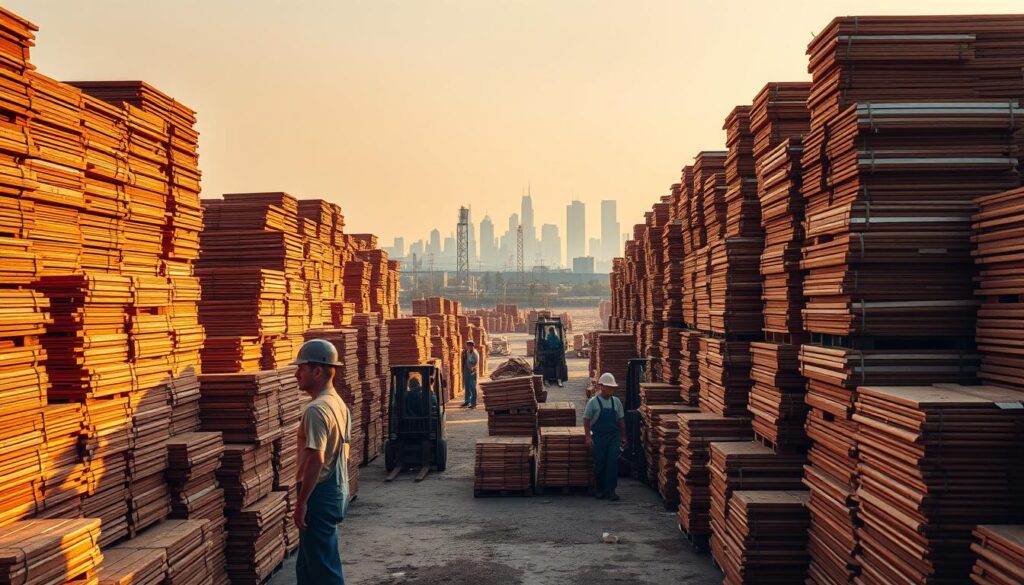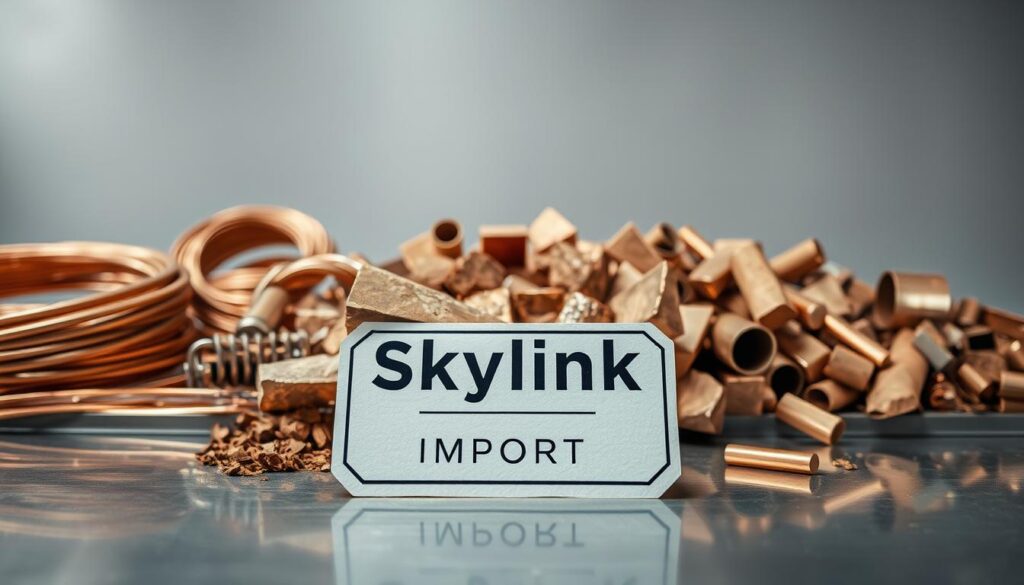
The global copper scrap market is experiencing significant growth, driven by the increasing demand for sustainable and environmentally friendly practices in metal recycling. Copper scrap is a vital component in various industries, including electronics, construction, and manufacturing.
Skylink Imports, a leading global import-export solutions provider, plays a crucial role in facilitating high-quality copper scrap exports. By bridging the gap between manufacturers and markets, they ensure unmatched efficiency, reliability, and transparency in the trade.
Key Takeaways
- Understanding the importance of copper scrap in global trade
- Identifying best practices for quality copper scrap exports
- Recognizing the role of Skylink Imports in facilitating copper scrap trade
- Learning about the benefits of sustainable copper scrap recycling
- Exploring the industries that rely heavily on copper scrap
The Global Copper Scrap Market Overview
The global copper scrap market is experiencing significant growth due to increasing demand for recycled copper. This growth is driven by the need for sustainable practices and the economic benefits of copper recycling.
Current Market Trends and Demand
The demand for copper scrap is on the rise, driven by the scrap metal industry’s growth and the increasing need for recycled materials. Key factors influencing this demand include:
- Rising copper prices
- Increasing industrial consumption
- Government regulations promoting recycling
Economic Importance of Copper Recycling
Copper recycling plays a vital role in the economy by conserving natural resources, reducing energy consumption, and decreasing waste. The economic benefits of copper recycling include:
- Job creation in the recycling sector
- Cost savings for manufacturers using recycled copper
- Reduced environmental impact

Key Export Destinations for United States Suppliers
The United States is a significant player in the global copper scrap market, with various countries importing U.S. copper scrap. Key export destinations include:
- China
- India
- South Korea
Understanding these trends and destinations is crucial for suppliers looking to maximize their exports and capitalize on the growing demand for copper scrap.
Understanding Copper Scrap Classifications
Understanding the various classifications of copper scrap is essential for exporters to navigate the global market effectively. Copper scrap is a vital component in the recycling industry, and its classification directly impacts its value and usability.
ISRI Grading Standards
The Institute of Scrap Recycling Industries (ISRI) provides a comprehensive grading system for copper scrap, ensuring a standardized classification across the industry. ISRI grading standards categorize copper scrap into various grades based on purity, composition, and other factors.
- ISRI Code: Each grade is assigned a specific ISRI code, facilitating international trade and communication among suppliers and buyers.
- Purity Levels: The grading system considers the purity of copper, with higher purity materials commanding better prices.
Common Types of Copper Scrap
Copper scrap is categorized into several types based on its source, composition, and condition. Some common types include:
- Copper Wire: Often used in electrical applications, copper wire is a highly sought-after scrap due to its high purity.
- Copper Tubing: Used in plumbing and other applications, copper tubing is another valuable source of copper scrap.
- Copper Clad Steel: This type of scrap is derived from materials like copper-clad steel wire, which is used in various industrial applications.
Value Differences Between Grades
The value of copper scrap varies significantly between different grades, primarily due to differences in purity and composition. Higher-grade copper scrap, with its higher purity levels, is more valuable and in greater demand.

By understanding these classifications and adhering to ISRI grading standards, exporters can ensure they are dealing with high-quality copper scrap, thereby enhancing the overall quality of their exports.
Quality Assessment Criteria for Copper Scrap
To ensure successful copper scrap exports, understanding quality assessment is key. The value of copper scrap is heavily influenced by its quality, which is determined through various assessment criteria.
Purity Levels and Testing Methods
The purity of copper scrap is a critical factor in its valuation. Testing methods such as spectroscopy and chemical assays are used to determine the purity levels. These tests help in identifying the presence of other metals or impurities.
- Spectroscopy: Uses light to identify the elemental composition.
- Chemical Assays: Involves chemical reactions to quantify the metal content.
Contamination Issues and Solutions
Contamination is a significant issue in copper scrap, affecting its quality and value. Common contaminants include other metals, plastics, and dirt. Effective sorting and segregation are crucial in minimizing contamination.
- Implementing strict sorting protocols.
- Using advanced technologies for the detection and removal of contaminants.
Visual Inspection Techniques
Visual inspection is a preliminary yet vital step in assessing copper scrap quality. It involves examining the scrap for visible contaminants, damage, or other quality-affecting factors. Trained inspectors can identify potential issues that may not be evident through other means.
By understanding and applying these quality assessment criteria, exporters can ensure they are dealing with high-quality copper scrap, thereby enhancing their reputation and profitability in the global market.
Sourcing High-Quality Copper Scrap
To ensure a consistent supply of premium copper scrap, exporters must develop robust sourcing strategies. This involves a comprehensive approach to identifying and partnering with reliable suppliers.
Building Reliable Supplier Networks
Skylink Imports, with its strong operational roots in India, specializes in sourcing and procurement, demonstrating the importance of establishing a robust supplier network. By leveraging their expertise, exporters can access high-quality copper scrap.
Due Diligence in Supplier Selection
Conducting thorough due diligence is crucial when selecting suppliers. This includes assessing their production capabilities, quality control measures, and compliance with international standards.
Quality Control at Source
Implementing quality control at the source ensures that the copper scrap meets the required standards. This proactive approach helps in minimizing contamination and maximizing the value of the scrap.
Establishing Long-term Supply Relationships
Building long-term relationships with suppliers is vital for securing a consistent supply of high-quality copper scrap. This not only ensures stability but also fosters collaboration and improvement in quality over time.
Processing and Preparation Best Practices
To ensure high-quality copper scrap exports, it’s essential to follow best practices in processing and preparation. Effective processing and preparation not only enhance the quality of the copper scrap but also increase its market value.
Sorting and Segregation Techniques
Proper sorting and segregation of copper scrap are critical for achieving high purity levels. This involves categorizing the scrap based on its type, grade, and level of contamination. Advanced sorting technologies, such as magnetic separation and eddy current separation, can be employed to improve efficiency and accuracy.
Cleaning and Decontamination Methods
Cleaning and decontamination are vital steps in preparing copper scrap for export. Techniques such as washing, drying, and chemical treatment can be used to remove impurities and contaminants. It’s crucial to ensure that the cleaning methods used do not damage the copper material.
Packaging for Export
Proper packaging for export is essential for protecting the copper scrap during transportation. This includes using suitable containers, securing the scrap to prevent movement, and covering the material to protect it from environmental factors. Compliance with international packaging standards is also necessary to avoid customs issues.
By implementing these best practices in processing and preparation, copper scrap exporters can significantly improve the quality of their products and maintain a competitive edge in the global market.
Discover the Best Practices for Best Quality Copper Scrap Exports
To excel in the copper scrap export industry, it’s essential to adopt best practices that guarantee high-quality shipments. Companies like Skylink Imports provide comprehensive export solutions that emphasize quality control and regulatory compliance.
Industry-Leading Quality Control Measures
Implementing industry-leading quality control measures is crucial for ensuring the consistency and purity of copper scrap exports. This involves:
- Rigorous sorting and segregation to separate different types of copper scrap based on their composition and quality.
- Advanced testing methods to verify the purity and composition of the copper scrap.
- Regular audits to ensure compliance with quality standards.
Documentation and Certification Requirements
Proper documentation and certification are vital for copper scrap exports. Exporters must comply with international regulations and standards, which include:
- Obtaining certificates of origin to verify the source of the copper scrap.
- Preparing detailed material specifications to inform buyers about the quality and composition of the shipment.
- Ensuring compliance with environmental and safety regulations through appropriate certifications.
Pre-Shipment Inspection Protocols
Pre-shipment inspections are critical to ensure that copper scrap exports meet the required quality and regulatory standards. These inspections involve:
- Visual inspections to check for contamination and ensure the material meets the specified requirements.
- Laboratory testing to verify the composition and purity of the copper scrap.
- Review of documentation to ensure all necessary certificates and records are in order.
Implementing Quality Management Systems
To maintain high standards in copper scrap exports, companies should implement robust quality management systems. This includes:
- Adopting ISO quality management standards to guide quality control processes.
- Establishing continuous improvement protocols to enhance quality and efficiency.
- Providing regular training to personnel involved in the handling and processing of copper scrap.
By following these best practices, exporters can ensure the quality of their copper scrap shipments, enhance their reputation, and maintain a competitive edge in the global market.
Regulatory Compliance for Copper Scrap Exports
Navigating the complex landscape of copper scrap exports requires a deep understanding of regulatory compliance. The copper scrap export industry is subject to a myriad of regulations that govern every aspect of the business, from environmental standards to customs documentation.
International Trade Regulations
International trade regulations play a crucial role in the export of copper scrap. Exporters must comply with regulations set forth by international trade organizations, as well as bilateral agreements between countries. Understanding these regulations is essential to avoid legal repercussions and financial penalties.
Environmental Compliance Standards
Copper scrap exports are also subject to environmental compliance standards. These standards ensure that the export and recycling of copper scrap do not harm the environment. Exporters must adhere to regulations regarding waste management and pollution control.
United States Export Controls
For exporters based in the United States, understanding U.S. export controls is vital. These controls regulate the export of copper scrap to certain countries and ensure compliance with national security and foreign policy objectives.
Customs Documentation Requirements
Proper customs documentation is critical for the smooth export of copper scrap. Exporters must ensure that all necessary documents, including commercial invoices and certificates of origin, are accurately prepared and submitted to customs authorities.
In conclusion, regulatory compliance is a multifaceted aspect of copper scrap exports that requires careful attention to detail. By understanding and adhering to international trade regulations, environmental compliance standards, U.S. export controls, and customs documentation requirements, exporters can ensure successful and compliant business operations.
Logistics and Transportation Considerations
Effective logistics and transportation are crucial for the successful export of copper scrap. Companies like Skylink Imports have expertise in managing the complexities of logistics, ensuring that shipments reach their destinations efficiently.
Container Selection and Loading Techniques
Choosing the right container and employing proper loading techniques are vital to prevent damage during transit. Containers must be dry, clean, and free of any contaminants to maintain the quality of the copper scrap.
Shipping Documentation Requirements
Accurate and complete shipping documentation is essential for smooth customs clearance. This includes commercial invoices, packing lists, and certificates of origin. Ensuring compliance with international regulations helps avoid delays.
Risk Management in Transit
Risk management strategies, such as insurance and secure packaging, mitigate potential losses during transportation. Monitoring shipments and having contingency plans in place are also crucial.
Cost Optimization Strategies
Optimizing logistics costs involves selecting the most efficient transportation modes, consolidating shipments, and negotiating with carriers. Skylink Imports’ expertise in logistics can help exporters achieve cost savings without compromising on service quality.
Pricing Strategies and Market Dynamics
Effective pricing strategies and a deep understanding of market dynamics are essential for copper scrap exporters looking to stay ahead. The global copper scrap market is subject to various factors that influence pricing and demand.
Price Determination Factors
The price of copper scrap is determined by several key factors, including global demand, supply chain logistics, and the purity of the copper. Market trends and economic indicators also play a significant role in shaping prices.
Hedging Against Market Volatility
To mitigate risks associated with market fluctuations, exporters can employ hedging strategies. This involves using financial instruments to lock in prices or protect against potential losses. Effective hedging requires a thorough understanding of market dynamics and the ability to predict future trends.
Negotiation Strategies with Buyers
Negotiating with buyers is a critical aspect of the copper scrap export business. Exporters must be skilled in negotiation techniques to secure favourable prices. Understanding the buyer’s needs and being flexible can lead to mutually beneficial agreements.
Timing Market Entry for Maximum Returns
The timing of market entry can significantly impact the profitability of copper scrap exports. Exporters need to analyze market trends and economic forecasts to determine the optimal time to enter the market. This strategic approach can help maximize returns on investment.
Sustainable Practices in Copper Scrap Exports
Sustainable practices are becoming a cornerstone for businesses involved in copper scrap exports, driven by both regulatory requirements and market demand. As the global economy continues to evolve, the importance of environmentally responsible practices in the copper scrap industry is gaining prominence.
Environmental Benefits of Copper Recycling
Copper recycling offers significant environmental benefits, including the conservation of natural resources and a reduction in energy consumption compared to primary copper production. By recycling copper, the industry can significantly decrease the environmental footprint associated with mining and processing raw copper.
Carbon Footprint Reduction Strategies
Implementing carbon footprint reduction strategies is crucial for copper scrap exporters. This can be achieved through efficient logistics, using renewable energy sources in processing facilities, and minimizing waste during the recycling process.
Circular Economy Principles
The adoption of circular economy principles is vital in the copper scrap industry. This involves designing recycling processes that are restorative and regenerative by design, ensuring that copper is continually cycled back into the economy.
Meeting Buyer Sustainability Requirements
To remain competitive, copper scrap exporters must meet buyer sustainability requirements. This includes providing detailed documentation on the sourcing and processing of copper scrap, as well as adhering to internationally recognized environmental standards.
| Sustainability Aspect | Action | Benefit |
|---|---|---|
| Environmental Impact | Recycling Copper | Conservation of Natural Resources |
| Carbon Footprint | Efficient Logistics | Reduced Emissions |
| Circular Economy | Designing Restorative Processes | Continual Recycling of Copper |
How Skylink Imports Facilitates Quality Copper Scrap Exports
In the complex world of copper scrap exports, Skylink Imports stands out for its comprehensive solutions. As a global import-export solutions provider, Skylink Imports has established itself as a trusted partner for businesses looking to export high-quality copper scrap.
Comprehensive Export Solutions
Skylink Imports offers a wide range of services designed to streamline the export process. From initial consultation to final delivery, their team provides expert guidance to ensure that all aspects of the export are handled efficiently. This includes assistance with documentation, logistics, and compliance with international regulations.
Quality Assurance Processes
Ensuring the quality of copper scrap is paramount. Skylink Imports implements rigorous quality assurance processes to guarantee that the material meets the required standards. This involves thorough inspections and testing to verify the purity and quality of the copper scrap.
Global Market Access and Logistics Expertise
With an extensive network and logistics expertise, Skylink Imports provides access to global markets, enabling businesses to reach new customers and expand their market share. Their knowledge of international trade regulations and shipping logistics ensures that exports are handled smoothly and efficiently.
Case Studies of Successful Copper Scrap Exports
Skylink Imports has a proven track record of successful copper scrap exports, as highlighted in their case studies. These examples demonstrate their ability to navigate complex export challenges and deliver results. According to one of their clients,
“Skylink Imports’ expertise and professionalism made our copper scrap export process seamless and profitable.”
By leveraging Skylink Imports’ comprehensive export solutions, businesses can ensure that their copper scrap exports are handled with the utmost care and professionalism, meeting the highest standards of quality and compliance.
Conclusion: Maximizing Value in Copper Scrap Exports
Maximizing value in copper scrap exports requires a multifaceted approach that encompasses best practices in quality control, regulatory compliance, and sustainable practices. By understanding the global copper scrap market, classifications, and quality assessment criteria, exporters can ensure they are providing high-quality material that meets international standards.
Implementing industry-leading quality control measures, such as those outlined by the Institute of Scrap Recycling Industries (ISRI), and adhering to regulatory compliance requirements are crucial for successful copper scrap exports. Furthermore, adopting sustainable practices not only benefits the environment but also enhances the reputation of exporters in the global market.
By following best practices and staying informed about market dynamics, exporters can maximize their returns and contribute to a more sustainable copper recycling industry. Companies like Skylink Imports facilitate quality copper scrap exports by providing comprehensive export solutions and quality assurance processes, making it easier for exporters to navigate the complexities of the global market.
Email us: info@skylinkimports.com
Contact us: Canada: +1 (403) 266-9394
India: +91-9041-543543
USA: +1 (917) 672-6581





